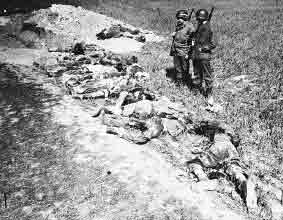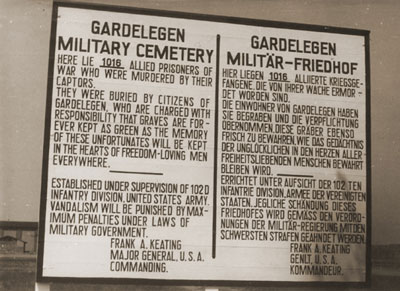Nazi War Crimes: Massacre at Gardelegen
(April 13, 1945)
In 1945, as Allied troops penetrated Nazi Germany, the SS began evacuating prisoners from concentration camps in outlying areas on death marches to the interior of the Reich. It was part of a desperate and hopeless effort to keep the war effort going and to prevent the inmates from falling into enemy hands, where they could testify against their persecutors.
 |
Following the U.S. Army's crossing of the Rhine River and push into central Germany , the SS camp administration at Dora-Mittelbau ordered the evacuation of prisoners from the main camp and a number of its affiliated subcamps on April 3 and 4th. The goal was to transport the inmates by train or by foot to the concentration camps in Bergen-Belsen, Sachsenhausen, or Neuengamme. Within days, some 4,000 prisoners from Dora-Mittelbau, its satellite camps, and a Neuengamme subcamp arrived in the Gardelegen area 90 miles west of Berlin, where they had to dismount from the freight cars because the trains could not advance any further due to air raid damage to the rail lines.
Greatly outnumbered by the prisoners, the SS guards began recruiting auxiliary forces from the local fire department, the air force, the aged home guard, the Hitler Youth, and other organizations to watch over the inmates. On April 13 (less than a month from the end of the Second World War), more than a thousand prisoners, many of them sick and too weak to march any further, were taken from the town of Gardelegen to a large barn on the Isenschnibbe estate and forced inside the building. The assembled guards then barricaded the doors and set fire to gasoline-soaked straw.
As the heat and flames expanded within the building, prisoners sought to escape the conflagration by digging under the barn's walls. They were killed by the guards. The next day, the SS and local auxiliaries returned to dispose of the evidence of their crime. They planned to incinerate what remained of the bodies and the barn, and kill any survivors of the blaze. The swift advance of the 102nd Infantry Division, however, prevented the SS and its accomplices from completely carrying out this plan.
On April 14, the 102nd (405th Regiment, 2d Battalion, F Company) entered Gardelegen and, the following day, discovered the atrocity. They found the corpses of 1,016 prisoners in the still-smoldering barn and nearby trenches, where the SS had the charred remains dumped. The also interviewed several of the prisoners who had managed to escape the fire and the shootings. Within days, U.S. Army Signal Corps photographers arrived to document the Nazi crime and by April 19, 1945, the story of the Gardelegen massacre began appearing in the western press. On that day, both the New York Times and The Washington Post ran stories on the massacre, quoting one American soldier who stated:
I never was so sure before of exactly what I was fighting for. Before this you would have said those stories were propaganda, but now you know they weren't. There are the bodies and all those guys are dead.
On April 21, 1945 , the local commander of the 102nd ordered between 200 and 300 men from the town of Gardelegen to give the murdered prisoners a proper burial. Over the next few days, the German civilians exhumed 586 bodies from the trenches and recovered 430 bodies from the barn, placing each in an individual grave. On April 25, the 102nd carried out a ceremony to honor the dead and erected a memorial tablet to the victims, which stated that the townspeople of Gardelegen are charged with the responsibility that the “graves are forever kept as green as the memory of these unfortunates will be kept in the hearts of freedom-loving men everywhere.” Also on April 25, Colonel George Lynch addressed German civilians at Gardelegen with the following statement:
The German people have been told that stories of German atrocites were Allied propaganda. Here, you can see for yourself. Some will say that the Nazis were responsible for this crime. Others will point to the Gestapo. The responsibility rests with neither -- it is the responsibility of the German people....Your so-called Master Race has demonstrated that it is master only of crime, cruelty and sadism. you have lost the respect of the civilized world.
 |
Discovery of the massacre seems to have been by chance. Consensus is that American Lieutenant Emerson Hunt, a liaison officer between Ozark HQ and the 701st Tank Battalion was captured by German forces on April 14, 1945. Lt. Hunt bluffed the German forces defending the town of Gardelegen into believing that American tanks were approaching the city, leading the German commander to surrender to American forces. The Americans arrived at the site before the Germans had time to bury all of the bodies. An investigation was undertaken by Lt. Col. Edward E. Cruise, Investigating Officer, Ninth Army War Crimes Branch.
Gardelegen is now a national memorial.
The sign at the cemetery reads:
Gardelegen Military Cemetery
Here lie 1016 allied prisoners of war who were murdered by their captors. They were buried by citizens of Gardelegen, who are charged with responsibility that graves are for- ever kept as green as the memory of these unfortunates will be kept in the hearts of freedom-loving men everywhere.______________
Established under supervision of 102d Infantry Division. United States Army Vandalism will be punished by maximum penalties under laws of military government.
Frank A. Keating Major General, U.S.A. Commanding
In a ceremony on September 15, 2020, 75 years after the Gardelegen massacre, German President Frank-Walter Steinmeier said a resurgence of “authoritarian and nationalist thought” underlined the importance of a new memorial to the victims. “The massacre here at Gardelegen was one of the last,” Steinmeier said in the presence of two survivors. “It is essential that we remember. That we safeguard the memory of crimes which many Germans, even today, know nothing about,” Steinmeier said, noting that the Nazis “killed until the last minute” of the war. Steinmeier also expressed regret that few people faced prosecution for the crimes committed in the final phase of the war, saying it was “shameful” that Gerhard Thiele, a local Nazi party leader accused of giving the order to burn down the barn, escaped justice. He was arrested by the Americans in 1945 but was released for unknown reasons and lived for decades under an assumed name.
Sources: Wikipedia;
U.S. Holocaust Memorial Museum;
“75 years on: Germany marks site of one of last Nazi massacres,” AFP, (September 15, 2020).


